On-Road Wireless EV Charging Systems as a Complementary to Fast Charging Stations in Smart Grids
Abstract
:1. Introduction
- We introduce a probabilistic framework to estimate the arrival rates of EVs at fast-charging stations, considering the inclusion of on-road wireless charging systems. This framework leverages real-world transportation data to predict temporal charging patterns, which enhances the accuracy of planning charging infrastructure.
- We employ Monte Carlo simulation to address uncertainties in EV user behaviors and charging preferences. This approach enables a detailed exploration of various charging scenarios, providing insights into the dynamic interaction between on-road wireless charging and traditional plug-in stations.
- We develop a queuing model to estimate charging loads at stations under different conditions, both with and without on-road wireless charging. This model aids in understanding how wireless charging can alleviate peak loads, ensuring stability and efficiency in EV charging station operations.
- We propose the integration of solar photovoltaic (PV) power to support wireless charging systems, creating a sustainable and eco-friendly charging infrastructure. By demonstrating how wireless charging reduces peak demands and distributes loads more evenly, this study highlights its potential to enhance grid stability and delay costly system upgrades.
2. On-Road Wireless Charging as a Complement to Fast-Charging Stations
3. EV Wireless Charging Systems
3.1. Inductive Charging
3.2. Resonant Inductive Coupling
3.3. Capacitive Coupling
Design Equations for Resonant Inductive Wireless Charging Approach
3.4. Mutual Inductance Between Two Air-Core Circular Coils with Lateral Misalignment and Axial Separation
3.5. Formula to Calculate the Amount of Charge Received by an EV Battery While Driving over a Charging Area at a Constant Speed
3.6. Formula to Calculate the Amount of Charge Received by an EV Battery While Stopped at Traffic Lights
3.7. Formula to Calculate the Amount of Charge Received by an EV Battery While Accelerating
4. Load Modeling of EV Plug-In Charging Stations
- The inter-arrival times of PEVs (time between arrivals) are independent and follow an exponential distribution, resembling a Poisson process, where the arrival of one PEV does not affect the arrival of another.
- The charging rates of PEVs per hour at the facility are independent and exponentially distributed, also resembling a Poisson process.
- Each Electric Vehicle Charging Facility (EVCF) can handle a maximum of 20% of the total projected number of plug-in electric vehicles (PEVs) on an average day. Four EVCFs collectively serve 80% of the estimated PEV population, with each EVCF accommodating a maximum of 20% of forecasted PEVs. The remaining 20% of PEVs are assumed to charge at alternative locations using Level-2 charging infrastructure.
- The typical hourly residential power consumption is estimated at 1500 kWh, translating to a calculated reference of 2.08 kW for overall electricity demand estimation.
- PEV population estimation, utilizing data from the National Household Travel Survey (NHTS), estimates the average number of vehicles per household at 1.9. Considering PEV penetration, the total number of households, and the average number of vehicles per household, this study calculates the number of PEVs for each year of the planning period.
- PEVs are designed to operate within an SOC range of 20% to 90%, resulting in a functional window of 70%. This range is chosen to balance optimal battery utilization with maintaining sufficient capacity for charging needs.
- The analysis assumes that PEVs are fully charged at home before commencing a journey, eliminating the need for additional charging during the trip, except for overnight recharging. Under this assumption, fast charging is treated as a supplemental option to regular home charging.
- This study leverages data from the National Household Travel Survey (NHTS), covering approximately 1,000,000 trips and 300,000 vehicles. To improve analytical precision, this study focuses on specific vehicle categories, including automobiles, sports utility vehicles, vans, and pickup trucks, while excluding incomplete data. Consequently, the refined dataset comprises 850,000 trips and 150,000 vehicles.
- For computational efficiency and relevance, vehicles traveling less than 20 miles in total daily distance (across all trips) are excluded from the analysis. These vehicles are considered to have a negligible impact on charging demand.
5. Results and Discussions
5.1. EV Wireless Charging Systems as Complements to EV Plug-In Fast-Charging Stations
5.2. EV Wireless Charging Systems at Traffic Lights
5.3. EV Wireless Charging Systems on Highways with Heavy Traffic
5.4. Comparison of Different Wireless Charging Scenarios
5.5. Wireless Charging Infrastructure Required
- Each EV stopping at a traffic light for 2 min can receive approximately of energy via wireless charging.
- The traffic light cycle repeats every 2.67 min, meaning a vehicle can stop a maximum of
- There is a 50% probability that an EV encounters a red light, enabling charging.
6. Conclusions
Author Contributions
Funding
Data Availability Statement
Conflicts of Interest
References
- Habib, S.; Khan, M.M.; Abbas, F.; Numan, M.; Ali, Y.; Tang, H.; Yan, X. A framework for stochastic estimation of electric vehicle charging behavior for risk assessment of distribution networks. Front. Energy 2020, 14, 298–317. [Google Scholar] [CrossRef]
- Aboshady, F.M.; Pisica, I.; Axon, C.J. A stochastic model for estimating electric vehicle arrival at multi-charger forecourts. Energy Rep. 2022, 8, 11569–11578. [Google Scholar] [CrossRef]
- Faridimehr, S.; Venkatachalam, S.; Chinnam, R.B. A Stochastic Programming Approach for Electric Vehicle Charging Network Design. IEEE Trans. Intell. Transp. Syst. 2018, 20, 1870–1882. [Google Scholar] [CrossRef]
- Tao, S.; Liao, K.; Xiao, X.; Wen, J.; Yang, Y.; Zhang, J. Charging demand for electric vehicle based on stochastic analysis of trip chain. IET Gener. Transm. Distrib. 2016, 10, 2689–2698. [Google Scholar] [CrossRef]
- Pashajavid, E.; Golkar, M.A. Charging of plug-in electric vehicles: Stochastic modelling of load demand within domestic grids. In Proceedings of the 20th Iranian Conference on Electrical Engineering (ICEE2012), Tehran, Iran, 15–17 May 2012; pp. 535–539. [Google Scholar] [CrossRef]
- Bi, X.; Chipperfield, A.; Tang, W.K. Coordinating Electric Vehicle Flow Distribution and Charger Allocation by Joint Optimization. IEEE Trans. Ind. Inform. 2021, 17, 8112–8121. [Google Scholar] [CrossRef]
- Gan, L.; Topcu, U.; Low, S.H. Optimal decentralized protocol for electric vehicle charging. IEEE Trans. Power Syst. 2013, 28, 940–951. [Google Scholar] [CrossRef]
- Hung, Y.C.; Lok, H.P.; Michailidis, G. Optimal routing for electric vehicle charging systems with stochastic demand: A heavy traffic approximation approach. Eur. J. Oper. Res. 2022, 299, 526–541. [Google Scholar] [CrossRef]
- Ivarsøy, E.; Torsæter, B.N.; Korpås, M. Stochastic Load Modeling of High-Power Electric Vehicle Charging—A Norwegian Case Study. In Proceedings of the 2020 International Conference on Smart Energy Systems and Technologies (SEST), Istanbul, Turkey, 7–9 September 2020. [Google Scholar]
- Irshad, U.B.; Rafique, S.; Town, G. Stochastic modelling of electric vehicle behaviour to estimate available energy storage in parking lots. IET Smart Grid 2020, 3, 760–767. [Google Scholar] [CrossRef]
- Yan, D.; Ma, C. Stochastic planning of electric vehicle charging station integrated with photovoltaic and battery systems. IET Gener. Transm. Distrib. 2020, 14, 4217–4224. [Google Scholar] [CrossRef]
- Shanmugam, Y.; Narayanamoorthi, R.; Vishnuram, P.; Bajaj, M.; Aboras, K.M.; Thakur, P. A Systematic Review of Dynamic Wireless Charging System for Electric Transportation. IEEE Access 2022, 10, 133617–133642. [Google Scholar] [CrossRef]
- Ahmad, A.; Alam, M.S.; Chabaan, R. A Comprehensive Review of Wireless Charging Technologies for Electric Vehicles. IEEE Trans. Transp. Electrif. 2017, 4, 38–63. [Google Scholar] [CrossRef]
- Kumar, K.; Gupta, S.; Nema, S. A review of dynamic charging of electric vehicles. In Proceedings of the 2021 7th International Conference on Electrical Energy Systems (ICEES), Chennai, India, 11–13 February 2021; Institute of Electrical and Electronics Engineers Inc.: Piscataway, NJ, USA, 2021; pp. 162–165. [Google Scholar] [CrossRef]
- Rahulkumar, J.; Narayanamoorthi, R.; Vishnuram, P.; Bajaj, M.; Blazek, V.; Prokop, L.; Misak, S. An Empirical Survey on Wireless Inductive Power Pad and Resonant Magnetic Field Coupling for In-Motion EV Charging System. IEEE Access 2023, 11, 4660–4693. [Google Scholar] [CrossRef]
- Aydin, E.; Kosesoy, Y.; Yildiriz, E.; Aydemir, M. Comparison of Hexagonal and Square Coils for Use in Wireless Charging of Electric Vehicle Battery. In Proceedings of the 2018 International Symposium on Electronics and Telecommunications (ISETC), Timisoara, Romania, 8–9 November 2018. [Google Scholar]
- Jeebklum, P.; Kirawanich, P.; Sumpavakup, C. Dynamic Wireless Power Transfer with a Resonant Frequency for Light Duty Electric Vehicle. Int. J. Intell. Eng. Syst. 2021, 14, 417–426. [Google Scholar] [CrossRef]
- Laporte, S.; Coquery, G.; Deniau, V.; Bernardinis, A.D.; Hautière, N. Dynamicwireless power transfer charging infrastructure for future evs: From experimental track to real circulated roads demonstrations. World Electr. Veh. J. 2019, 10, 84. [Google Scholar] [CrossRef]
- Vatsala; Ahmad, A.; Alam, M.S.; Chaban, R.C. Efficiency Enhancement of Wireless Charging For Electric Vehicles Through Reduction of Coil Misalignment. In Proceedings of the 2017 IEEE Transportation Electrification Conference and Expo (ITEC), Chicago, IL, USA, 22–24 June 2017. [Google Scholar]
- Fisher, T.M.; Farley, K.B.; Gao, Y.; Bai, H.; Tse, Z.T.H. Electric vehicle wireless charging technology: A state-of-the-art review of magnetic coupling systems. Wirel. Power Transf. 2014, 1, 87–96. [Google Scholar] [CrossRef]
- Mahesh, A.; Chokkalingam, B.; Mihet-Popa, L. Inductive Wireless Power Transfer Charging for Electric Vehicles-A Review. IEEE Access 2021, 9, 137667–137713. [Google Scholar] [CrossRef]
- Gao, Y.; Ginart, A.; Farley, K.B.; Tse, Z.T.H. Misalignment Effect on Efficiency of Wireless Power Transfer for Electric Vehicles. In Proceedings of the 2016 IEEE Applied Power Electronics Conference and Exposition (APEC), Long Beach, CA, USA, 20–24 March 2016. [Google Scholar]
- Jafari, E.; Boyles, S.D. Online Charging and Routing of Electric Vehicles in Stochastic Time-Varying Networks. Transp. Res. Rec. 2017, 2667, 61–70. [Google Scholar] [CrossRef]
- Alfraidi, W.; Shalaby, M.; Alaql, F. Modeling EV Charging Station Loads Considering On-Road Wireless Charging Capabilities. World Electr. Veh. J. 2023, 14, 313. [Google Scholar] [CrossRef]
- Yin, X.; Lu, S.; Wang, Y.; Du, Z. Wireless charging structure and efficiency analysis based on wind–solar hybrid power supply system. Energy Rep. 2022, 8, 746–755. [Google Scholar] [CrossRef]
- Zhang, X.; Meng, H.; Wei, B.; Wang, S.; Yang, Q. Mutual inductance calculation for coils with misalignment in wireless power transfer. J. Eng. 2019, 2019, 1041–1044. [Google Scholar] [CrossRef]
- Zhang, X.; Quan, C.; Li, Z. Mutual Inductance Calculation of Circular Coils for an Arbitrary Position with Electromagnetic Shielding in Wireless Power Transfer Systems. IEEE Trans. Transp. Electrif. 2021, 7, 1196–1204. [Google Scholar] [CrossRef]
- Li, G.; Zhang, X.P. Modeling of plug-in hybrid electric vehicle charging demand in probabilistic power flow calculations. IEEE Trans. Smart Grid 2012, 3, 492–499. [Google Scholar] [CrossRef]
- Liu, Z.; Wen, F.; Ledwich, G. Optimal planning of electric-vehicle charging stations in distribution systems. IEEE Trans. Power Deliv. 2013, 28, 102–110. [Google Scholar] [CrossRef]
- Kendall, D.G. Stochastic Processes Occurring in the Theory of Queues and their Analysis by the Method of the Imbedded Markov Chain. Ann. Math. Stat. 1953, 24, 338–354. [Google Scholar] [CrossRef]
- Kulkarni, V.G. Modeling, Analysis, Design, and Control of Stochastic Systems, 1st ed.; Springer: New York, NY, USA, 1999; Volume 362. [Google Scholar]
- GAMS Development Corporation. General Algebraic Modeling System (GAMS), Software. Available online: https://www.gams.com (accessed on 4 May 2024).
- Miller, J.M.; Jones, P.T.; Li, J.M.; Onar, O.C. ORNL experience and challenges facing dynamic wireless power charging of EV’s. IEEE Circuits Syst. Mag. 2015, 15, 40–53. [Google Scholar] [CrossRef]
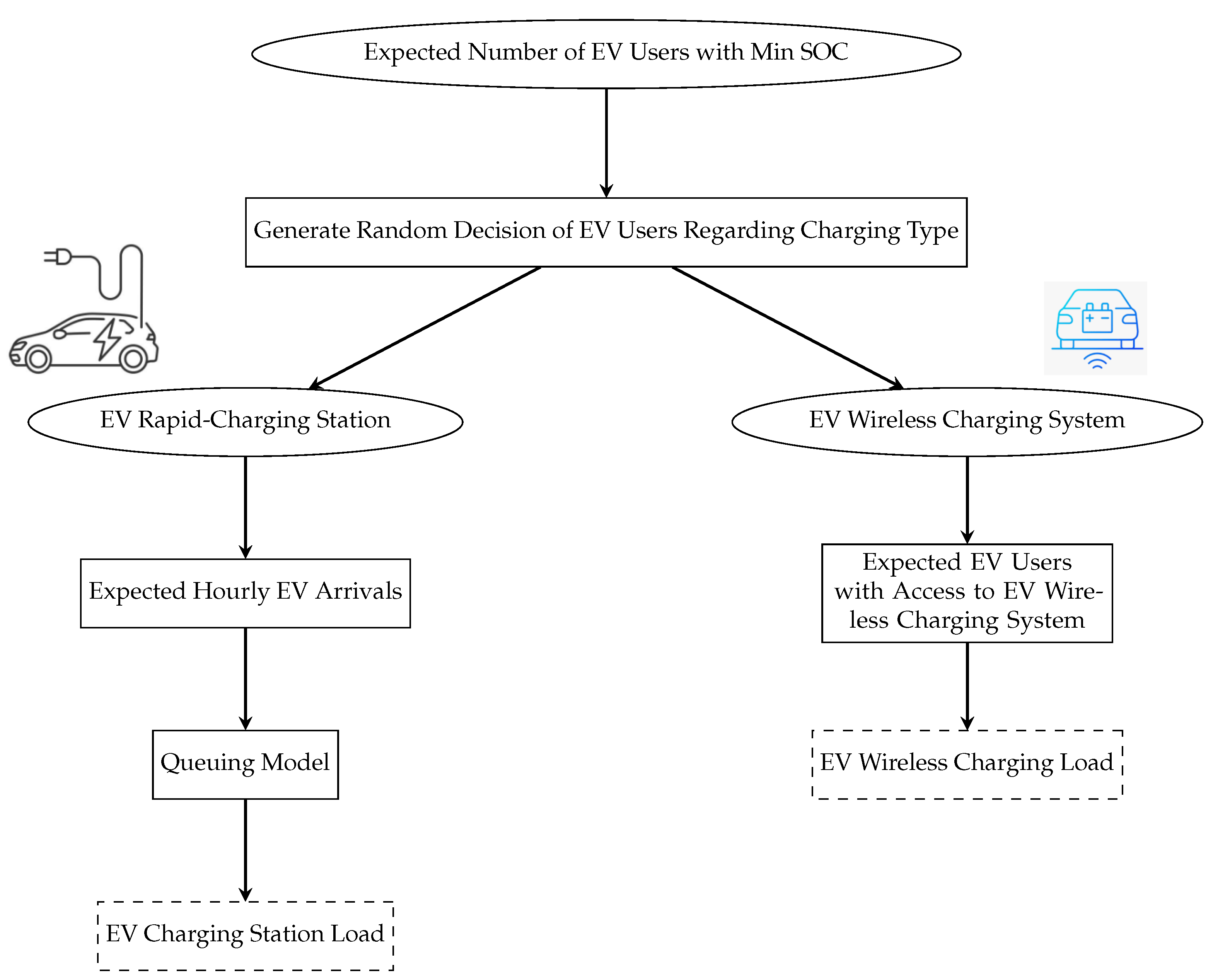
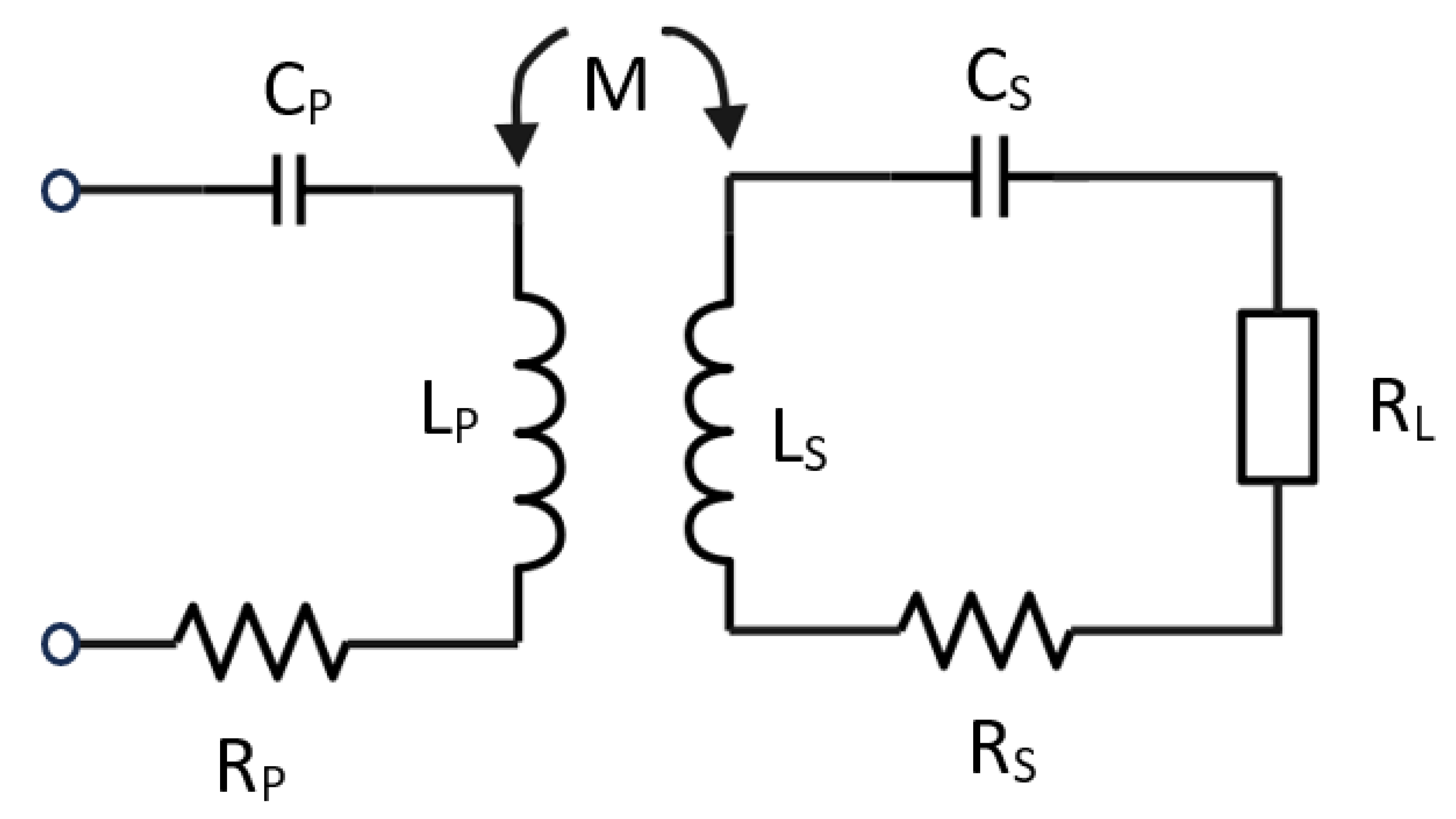


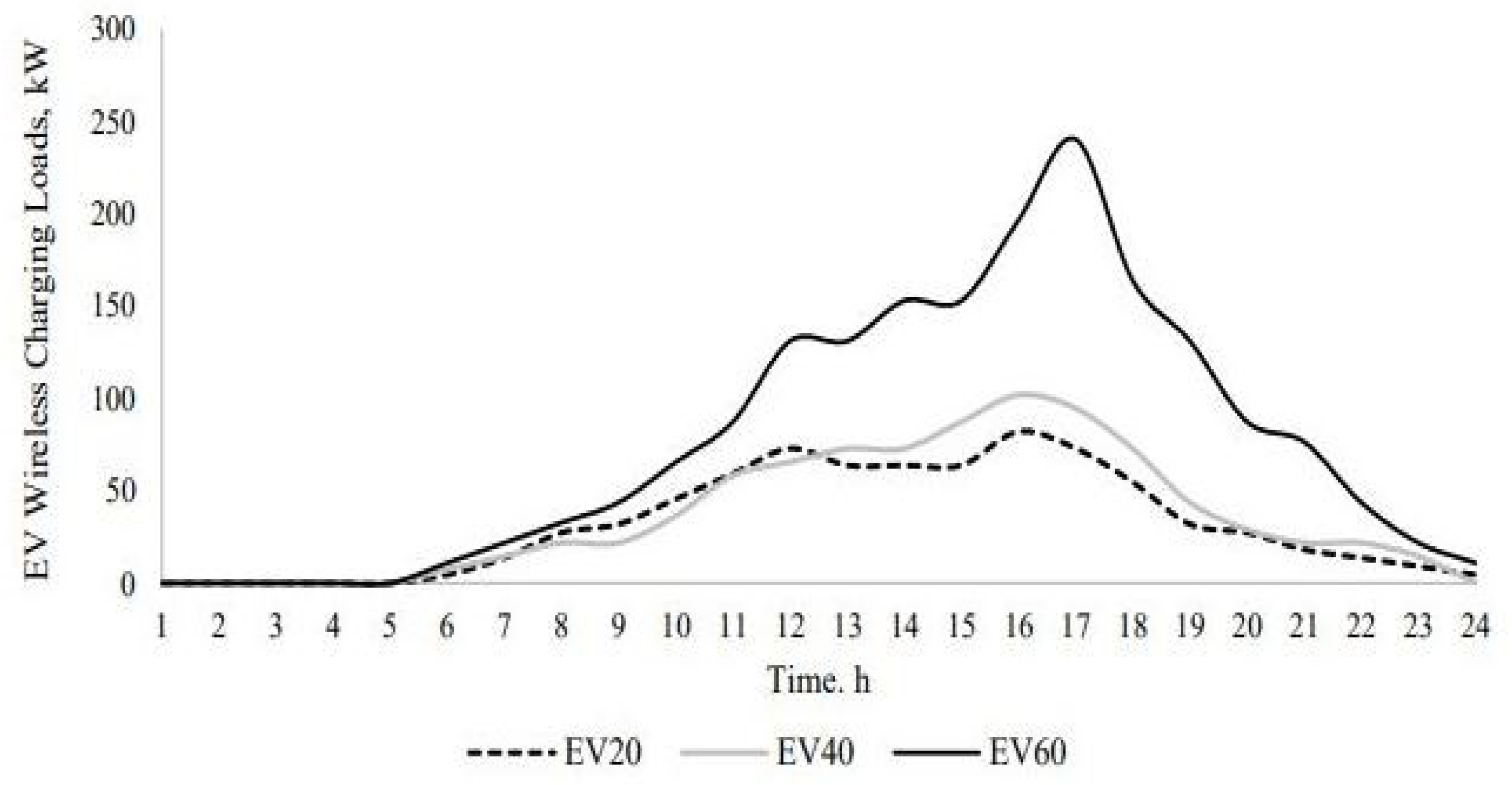
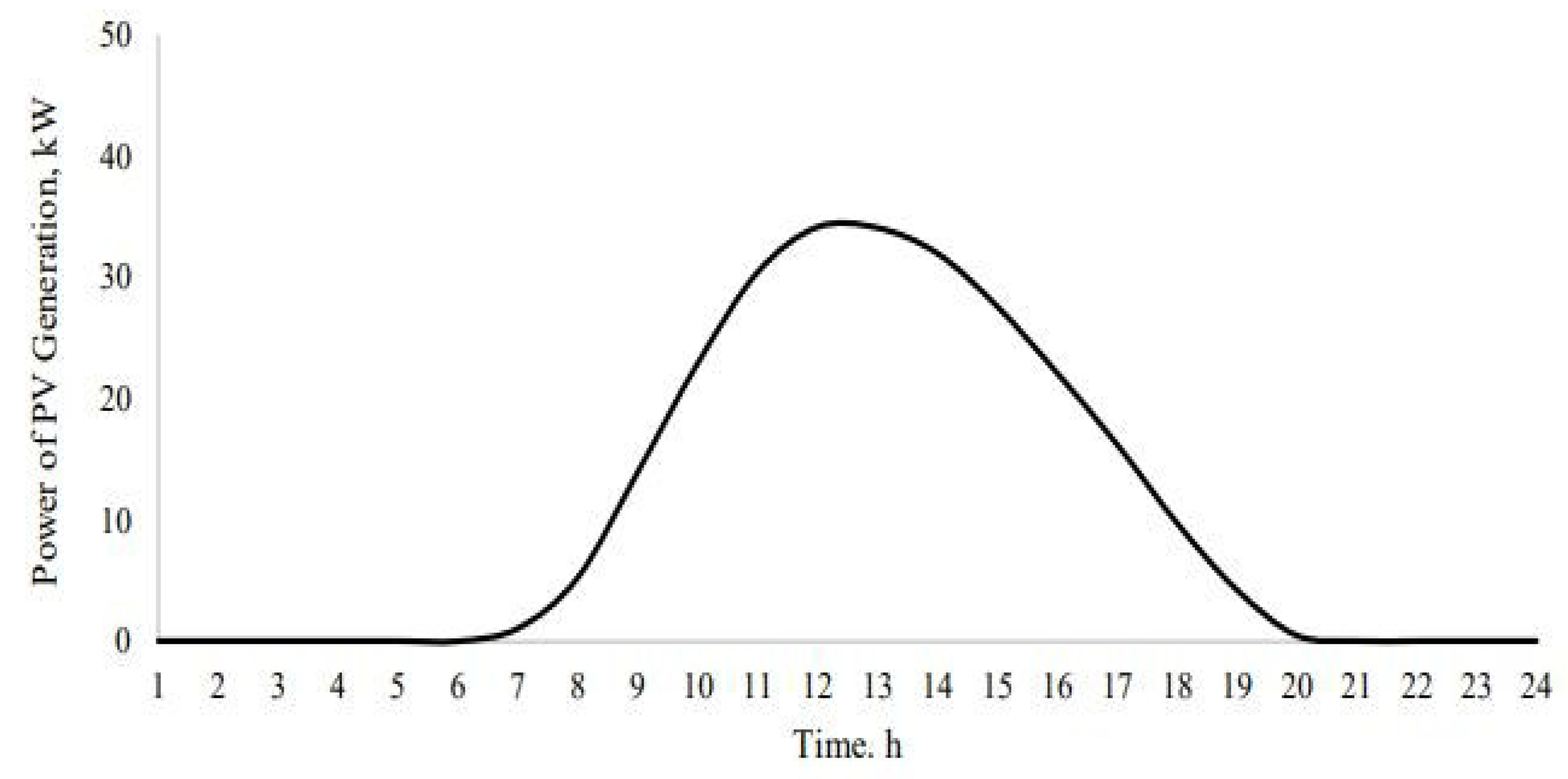

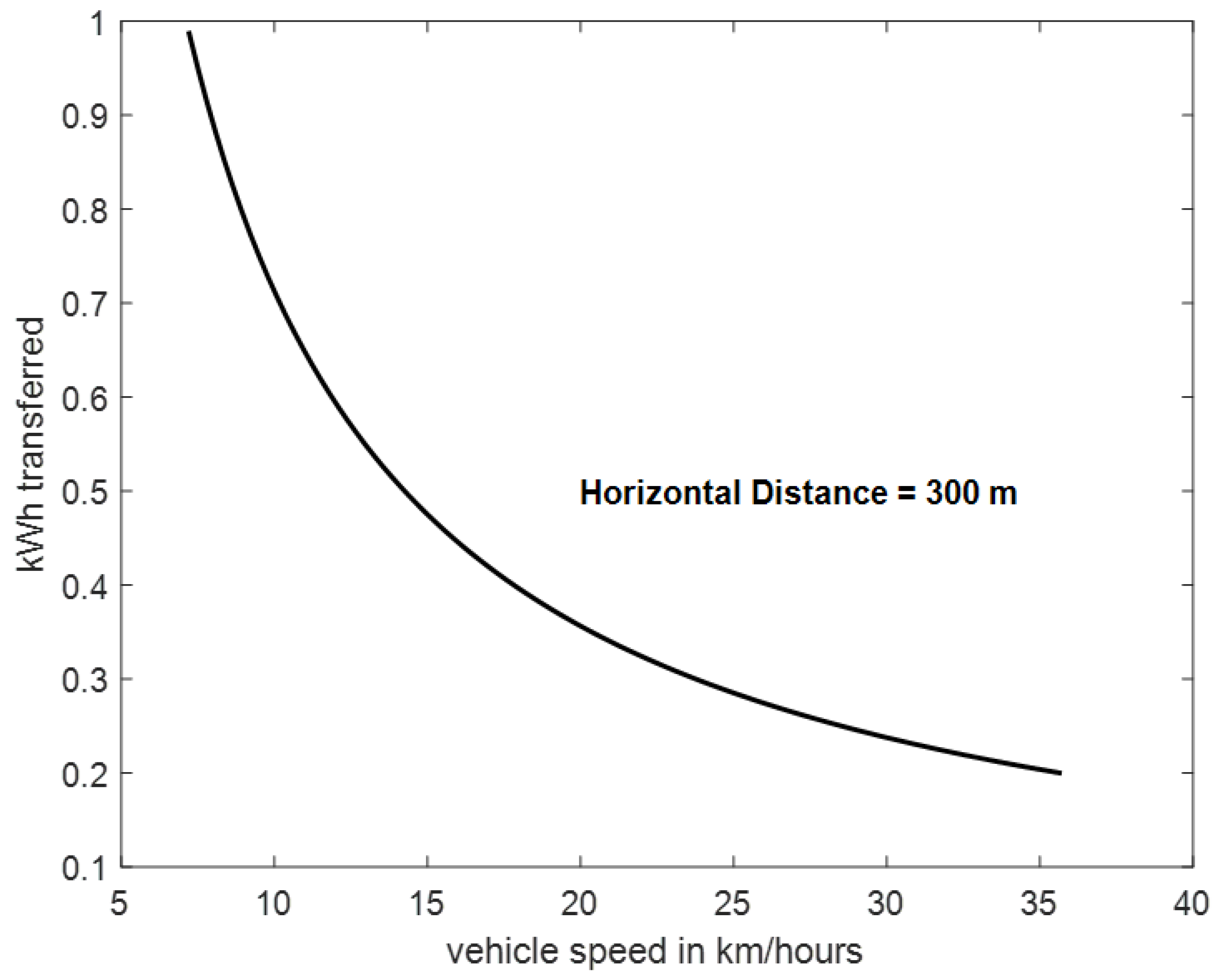
| Description | Value |
|---|---|
| Self-Inductance (transmitting coil)/μH | 238 |
| Self-Inductance (receiving coil)/μH | 77.5 |
| Resonant Capacitor (transmitting side)/nF | 14.7 |
| Resonant Capacitor (receiving side)/nF | 45.2 |
| Frequency/kHz | 85 |
| Parameter | Value |
|---|---|
| Maximum power available from solar panels at each traffic light (kW) | 50 |
| Number of electric vehicles at each traffic light | 1 |
| Time at traffic light (minutes) | 2 |
| Acceleration before reaching and after leaving the traffic light (±10 km/h/s) | ±10 |
| Horizontal distance of wireless charging at each traffic light (meters) | 2 × 150 |
| Amount of energy transferred @ one traffic light per 1 EV @ noon (kWh) | 0.54 |
| Parameter | Value |
|---|---|
| Maximum power available from solar panels at each section of high-traffic location (kW) | 50 |
| Number of electric vehicles passing and sharing this section | 1 |
| Horizontal distance of wireless charging at each high-traffic location (meters) | 300 |
| Average speed during high traffic (km/h) | 15 |
| Amount of energy transferred (kWh) | 0.15 |
Disclaimer/Publisher’s Note: The statements, opinions and data contained in all publications are solely those of the individual author(s) and contributor(s) and not of MDPI and/or the editor(s). MDPI and/or the editor(s) disclaim responsibility for any injury to people or property resulting from any ideas, methods, instructions or products referred to in the content. |
© 2025 by the authors. Published by MDPI on behalf of the World Electric Vehicle Association. Licensee MDPI, Basel, Switzerland. This article is an open access article distributed under the terms and conditions of the Creative Commons Attribution (CC BY) license (https://creativecommons.org/licenses/by/4.0/).
Share and Cite
Alorifi, F.; Alfraidi, W.; Shalaby, M. On-Road Wireless EV Charging Systems as a Complementary to Fast Charging Stations in Smart Grids. World Electr. Veh. J. 2025, 16, 99. https://doi.org/10.3390/wevj16020099
Alorifi F, Alfraidi W, Shalaby M. On-Road Wireless EV Charging Systems as a Complementary to Fast Charging Stations in Smart Grids. World Electric Vehicle Journal. 2025; 16(2):99. https://doi.org/10.3390/wevj16020099
Chicago/Turabian StyleAlorifi, Fawzi, Walied Alfraidi, and Mohamed Shalaby. 2025. "On-Road Wireless EV Charging Systems as a Complementary to Fast Charging Stations in Smart Grids" World Electric Vehicle Journal 16, no. 2: 99. https://doi.org/10.3390/wevj16020099
APA StyleAlorifi, F., Alfraidi, W., & Shalaby, M. (2025). On-Road Wireless EV Charging Systems as a Complementary to Fast Charging Stations in Smart Grids. World Electric Vehicle Journal, 16(2), 99. https://doi.org/10.3390/wevj16020099






